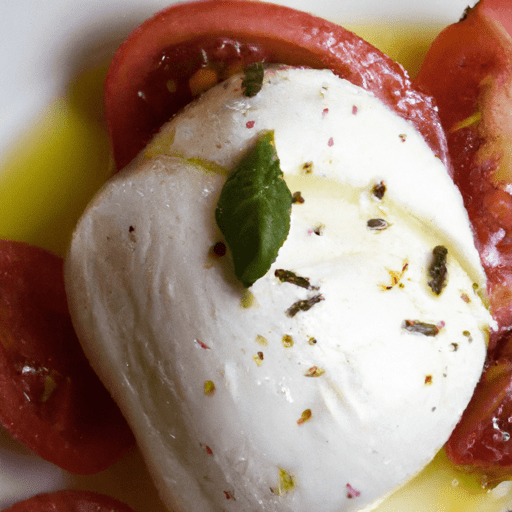Discover the Creamy Delight: Burrata Cheese
If you’re a cheese lover, then you’re in for a treat! Today, we’re going to dive into the world of burrata cheese. This Italian delicacy is renowned for its lusciously creamy and delicate texture. With its origins dating back to the early 20th century in the Apulia region of Italy, burrata has captured the hearts and taste buds of food enthusiasts around the globe. Join me as we uncover the wonders of this luxurious cheese.
Taste, Texture, and Aroma
Burrata cheese is a true masterpiece in the world of dairy. The exterior of this cheese has a smooth and elegant appearance, similar to a white ball of mozzarella. However, it’s the interior that makes burrata truly special. As you cut into the cheese, you’ll release a rich indulgence of creamy, stringy curd and fresh cream that oozes out.
The flavor profile of burrata is mild and delicate, with a subtle tanginess and notes of sweetness. Its creaminess provides a luxurious mouthfeel, making it an absolute delight to savor. Each mouthful delivers a perfect balance of savory and milky flavors that pair beautifully with a wide array of ingredients.
Versatile in the Kitchen
Burrata cheese is incredibly versatile and offers countless possibilities in the kitchen. Its creamy texture and mild flavor make it a perfect partner for both sweet and savory dishes.
In the world of salads, burrata often takes the spotlight as a star ingredient. Combining it with ripe tomatoes, fresh basil, and a drizzle of extra virgin olive oil creates a classic and irresistible caprese salad. Alternatively, you can get creative and incorporate burrata into a variety of other salads, pairing it with ingredients such as arugula, roasted vegetables, or even citrus fruits.
Another popular way to enjoy burrata is on top of pizza or flatbread. The creamy cheese adds a wonderful richness and provides a lovely contrast to the crispy crust. You can also place burrata in the center of a baked pasta dish for a creamy surprise when you cut into it. The possibilities are endless!
Nutritional Value
While burrata is undeniably delicious, it’s important to consider its nutritional value. As a dairy product, it is an excellent source of calcium, protein, and vitamins such as riboflavin and vitamin B12. However, it is worth noting that burrata is high in saturated fats and calories, so moderation is key when indulging in this creamy delight.
History and Fun Facts
Burrata cheese has an intriguing history that adds to its allure. Originally created as a way to use up excess curd and cream, it was made by wrapping the scraps of mozzarella in a tender pouch of fresh cheese. This method allowed cheesemakers to extend the shelf life of the curd while creating a unique and luxurious product.
In Italian, the word “burrata” translates to “buttered,” which perfectly describes the rich and smooth nature of this cheese. Traditionally, burrata was made using water buffalo milk, but nowadays, it is also commonly made with cow’s milk, making it more accessible internationally.
Conclusion
Burrata cheese presents a taste experience like no other, with its creamy texture, delicate flavor, and endless culinary possibilities. From salads to pizzas and beyond, this heavenly cheese is a true delight for food enthusiasts everywhere. Just remember to savor it in moderation due to its higher fat content. So, go ahead and treat yourself to the creamy indulgence that is burrata cheese – your taste buds will thank you!
Note: While burrata is traditionally made from cow’s or water buffalo’s milk, be sure to check the labeling or ask your cheesemonger if you have any dietary restrictions or preferences.
Origin:
- Burrata cheese originated in the region of Apulia, Italy. It was first created in the early 20th century, specifically in the town of Andria.
Common uses:
- Burrata is commonly used in salads, pasta dishes, and as a filling for sandwiches.
- It is often served fresh, at room temperature, to fully enjoy its creamy texture and flavors.
- Burrata can also be enjoyed with crusty bread, drizzled with olive oil, and sprinkled with salt and pepper.
Nutritional benefits:
- Burrata is a good source of protein, calcium, and vitamin A.
- It is relatively high in calories due to its creamy texture and richness, so portion control is recommended.
Unique properties:
- Burrata is a fresh cheese made from cow’s milk. It has an outer shell made of stretched and solidified mozzarella cheese, while the interior is filled with a mixture of cream and more stringy curd.
- Unlike other types of cheese, burrata has a soft and creamy texture with a rich and tangy flavor. It has a delicate, milky taste that pairs well with a variety of ingredients.
- The name “burrata” means “buttered” in Italian, which reflects its luxurious and buttery characteristics.
Historical significance:
- Originally, burrata was made as a way to use up leftover scraps of mozzarella cheese. The concept of stuffing the curd with cream was introduced to create a unique and indulgent cheese.
- Burrata has gained popularity and become part of traditional Italian cuisine, both in its native region and around the world. Its unique combination of creamy and stringy textures has made it a sought-after delicacy.




Use the share button below if you liked it.
It makes me smile, when I see it.